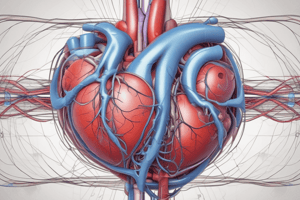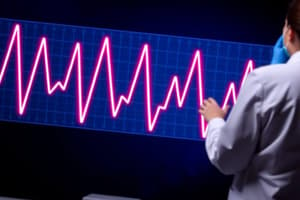Podcast
Questions and Answers
What medication should be given to a patient with Long QT syndrome in an acute setting?
What medication should be given to a patient with Long QT syndrome in an acute setting?
- Amiodarone
- Magnesium sulfate (correct)
- Beta blockers
- Quinidine
Which classes of antiarrhythmic drugs increase the risk of QT prolongation?
Which classes of antiarrhythmic drugs increase the risk of QT prolongation?
- Class I and Class II
- Class II and Class IV
- Class I and Class III (correct)
- Class III and Class IV
What do patients typically feel when experiencing Torsades De Pointes?
What do patients typically feel when experiencing Torsades De Pointes?
- Dizziness and fatigue
- Shortness of breath
- Skipped beats, palpitations, racing heart, chest discomfort/pain/pressure (correct)
- Numbness and tingling
What takes longer in a long QT interval?
What takes longer in a long QT interval?
Which class of antiarrhythmics decreases heart contractility by causing a blockade of calcium channels in the SA node AV node?
Which class of antiarrhythmics decreases heart contractility by causing a blockade of calcium channels in the SA node AV node?
Which class of antiarrhythmics is Amiodarone a prototype drug for?
Which class of antiarrhythmics is Amiodarone a prototype drug for?
True or false: all the drugs used to treat dysrhythmias can cause dysrhythmias.
True or false: all the drugs used to treat dysrhythmias can cause dysrhythmias.
Beta blockers belong to which class of antiarrhythmics?
Beta blockers belong to which class of antiarrhythmics?
What type of blockers prevent cardiac output?
What type of blockers prevent cardiac output?
What is the effect of Class I sodium channel blockers on action potentials?
What is the effect of Class I sodium channel blockers on action potentials?
What is the mechanism of action of Calcium Channel Blockers?
What is the mechanism of action of Calcium Channel Blockers?
What is the effect of Class II antiarrhythmics on the heart?
What is the effect of Class II antiarrhythmics on the heart?
What is the prototype drug for Class 1A sodium channel blockers?
What is the prototype drug for Class 1A sodium channel blockers?
What is the major side effect of Amiodarone?
What is the major side effect of Amiodarone?
What is the effect of Potassium Channel Blockers on cardiac cells?
What is the effect of Potassium Channel Blockers on cardiac cells?
Which class of antiarrhythmics is associated with QT prolongation?
Which class of antiarrhythmics is associated with QT prolongation?
What is the effect of Class IV calcium channel blockers on the heart?
What is the effect of Class IV calcium channel blockers on the heart?
Which of the following is a side effect of Non-selective beta blockers?
Which of the following is a side effect of Non-selective beta blockers?
What is the major risk associated with Class 1A sodium channel blockers?
What is the major risk associated with Class 1A sodium channel blockers?
Which class of antiarrhythmics does beta blockers belong to?
Which class of antiarrhythmics does beta blockers belong to?
What is the mechanism of action of beta blockers?
What is the mechanism of action of beta blockers?
What are the clinical uses of beta blockers?
What are the clinical uses of beta blockers?
What type of arrhythmia is Amiodarone primarily indicated for?
What type of arrhythmia is Amiodarone primarily indicated for?
Can Amiodarone cross the blood-brain barrier?
Can Amiodarone cross the blood-brain barrier?
What is the side effect of Amiodarone?
What is the side effect of Amiodarone?
Which class of antiarrhythmics includes Amiodarone?
Which class of antiarrhythmics includes Amiodarone?
What is the mechanism of action of Class III antiarrhythmics?
What is the mechanism of action of Class III antiarrhythmics?
Does Amiodarone accumulate in the tissues?
Does Amiodarone accumulate in the tissues?
Flashcards are hidden until you start studying
Study Notes
Cardiac II
Long QT Syndrome
- In an acute setting, magnesium sulfate should be given to a patient with Long QT syndrome.
- Long QT syndrome is associated with delayed repolarization, when the heart is supposed to be relaxing but a beat hits into that relaxation period.
Antiarrythmic Drugs
- Class I: Sodium channel blockers (Quinidine) and Class III: Potassium Channel Blockers (Amiodarone) increase the risk of QT prolongation.
- Other medications associated with increased risk of QT prolongation include Antipsychotics, Antidepressants (mental health drugs), and antibiotics.
Torsedes De Pointes
- A patient experiencing Torsedes De Pointes may feel skipped beats, palpitations, racing heart, and chest discomfort or pain/pressure.
Classes of Antiarrythmics
- Class I sodium channel blockers are the largest group of antiarrhythmics.
- Mnemonic to remember classes of antiarrhythmics: SODIUM BLOCKERS PREVENT CARDIAC OUTPUT
- Class II: beta blockers, Class IV: Calcium Channel Blockers, and Class V: Others (Adenosine)
MOA of Class I Sodium Channel Blockers
- Blocks sodium from entering nerve cells along the axon, which blocks action potentials along nerves in the heart, thus decreasing the speed of impulse across atria and ventricles.
Class 1A Sodium Channel Blockers
- Prototype drug: Quinidine (PO), Procainamide (IV)
- Major risks: QT prolongation
Beta Blockers
- Belong to Class II antiarrhythmics
- MOA: Decrease the automaticity of the SA node and slow the conduction through the AV node, helping control tachyarrythmias.
- Clinical uses: Antihypertension, heart failure, angina, myocardial infarction, arrhythmias
- First generation: Non-selective (Propranolol); cause bradycardia, hypotension, and broncospasms
- Second generation: Beta 1 selective (Metoprolol, Atenolol); slow down heart rate. Preferred for patients with respiratory issues since it does not impact lungs.
- Third generation: Non-selective with additional actions blocking B1, B2, and A1 adrenergic receptors (Carvedilol, labetelol); also blocks alpha 1 so it helps with hypertension.
Class III Antiarrythmics
- Belong to Potassium Channel Blockers
- MOA: Block potassium channels, preventing efflux of potassium from the cell, which leads to a delayed repolarization of the cardiac cell membrane.
- Prototype drug: Amiodarone
- Side effects: Pulmonary toxicity, thyroid dysfunction, hepatotoxicity, optic neuropathy, blue gray skin color changes. Also, hypotension, bradycardia, and QT prolongation.
Class IV Antiarrythmics
- Belong to Calcium Channel Blockers
- MOA: Slow down heart rate by inhibiting the influx of calcium ions during the cardiac action potential, particularly affecting the AV and SA nodes.
Class V Antiarrythmics
- Include Atropine, Digoxin, and Adenosine
Studying That Suits You
Use AI to generate personalized quizzes and flashcards to suit your learning preferences.




